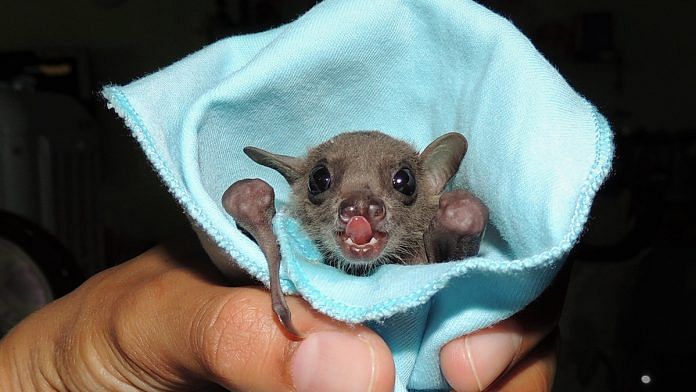Bengaluru: Bats are known to carry thousands of viruses, many of which are capable of infecting other mammals. Yet, the flying animals do not develop diseases or show symptoms of the diseases the viruses cause.
Scientists have been slowly gathering clues about the bat’s immune response and how it protects itself, and a new paper published Wednesday sheds more light on this.
The paper in Nature journal states that over the years, 10 genes in bats that produced an inflammatory response to infection became disabled, while the antiviral genes, which prevent viral replication, became stronger and greater in quantity.
The study was conducted by an international consortium called Bat1k project that aims to sequence the genomes of all 1,421 species of bats, in collaboration with the Vertebrate Genome Project, which aims to sequence genome assemblies of the existing approximately 70,000 species of vertebrates.
Also read: Here’s how scientists know the coronavirus came from bats and not a lab
Bat genome versus other mammal genomes
To understand a bat’s immune response, researchers sequenced the genome of six bat species, all of which were insectivorous or fruit eating. The six genomes were compared against the genome sequences of 42 other mammals.
The researchers found widely varying genetic differences and were able to identify parts of the genome that evolved differently in bats, giving rise to unique protective and adaptive characteristics, such as both protection from pathogens they harbour and the ability to fly.
The team discovered that at least 10 disabled genes are responsible for an inflammatory response, further solidifying evidence that bats do not undergo inflammation because of flying.
Flying for long periods of time with strong flapping of wings would typically result in a lot of cellular damage, which would then trigger an immune response.
The immune systems of bats have been studied in some detail, and one of the key findings is that bats lack inflammasomes, which are proteins that cause swelling, redness, soreness, pain and heat in localised injured areas of the body.
The team further found that bats also have extra copies of and stronger mutations in antiviral genes, which are found in all mammals and work to prevent viruses from replicating.
A prominent antiviral gene found in humans is the RSAD2 gene that prevents an umbrella of viruses — including the ones that cause influenza, dengue, chikungunya, and even HIV — from multiplying in the body and is a part of the body’s immune response. The gene produces a protein called Viperin to block replication.
The researchers additionally discovered that the bat genomes contained substantial amounts of DNA and RNA virus remnants, maintaining a kind of fossilised record of all past infections.
Also read: Don’t demonise bats, we need them: Researchers explain why ‘mass hysteria’ is uncalled for
Bat ancestry traced
The genome sequences also helped the team trace the ancestry of bats and further refine their position on the animal life tree.
They found that bats aren’t as closely related to animals like mice or lemurs as previously thought. Instead, they branched off to form a separate group 65 million years ago — around or shortly after the extinction of dinosaurs — from the ancestors of modern mammals like dogs, horses, and whales.
The study also identified genes that bats use in echolocation, the detection of surroundings though reflected sound waves. The phenomenon of echolocation was thought to be new in the evolutionary tree, but the genome sequences indicated that the impressive sonar ability was already present in ancestors of modern bats.
Bats are the only mammals capable of sustained flight and have evolved unique adaptations for it. They also play an important role in the ecosystem by controlling insect populations and performing large-scale pollination.
Virus reservoirs
Bats host over 10,000 identified viruses, which they can spread to other animals. Several emerging zoonotic infectious viruses such as Nipah, Hendra, SARS and MERS, have been traced back to bats. Viruses from bat populations have jumped to the human population through a variety of intermediate mammalian host animals like pigs, camels, civet cats, etc.
The new findings help us understand the evolution of mammals and their defensive mechanisms, providing us with information to work on our defence against novel viruses. Bat immune system offers potential solutions for how we can treat and prevent viruses, including the SARS-CoV-2 virus that causes the Covid-19 disease.
Also read: Live with bats or kill them? There is a third option even during coronavirus crisis



